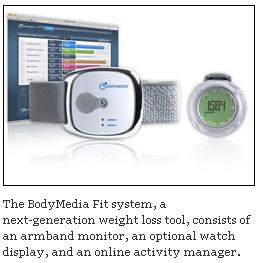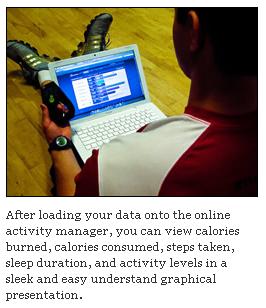BodyMedia FIT Weight Management System
By Adam Brown

by adam brown
For many people with diabetes, weight loss is often extremely difficult, especially given that certain diabetes medications like insulin can cause weight gain. As difficult as this process is, success is based on a simple principle: calories expended must exceed calories consumed. Most approaches to weight loss focus on the intake side by employing a calorie-restricted diet. While these are often effective, they typically neglect the other half of the weight loss equation, calories expended. At diaTribe this month, we had the opportunity to test a new consumer product that tracks calories burned on a minute-to-minute basis.
The BodyMedia FIT Weight Management System is astonishingly uncomplicated. The system consists of an armband monitor, an online activity manager, and an optional watch display. The armband monitor is a small, lightweight plastic device fitted into a flexible strap. It is worn on the back of the triceps and, according to the manufacturer, tracks calories burned throughout the day with 90% accuracy. The monitor uses four sensors to determine the number of calories burned, the number of steps taken, the total time spent in physical activity, and sleep duration/efficiency. These sophisticated sensors function by monitoring skin temperature, sweat, motion, and the rate at which heat is dissipating from the user’s body. In other words, the BodyMedia FIT system provides a vastly more complete picture of calorie burn, a tremendous improvement from overly simplistic pedometers and heart rate monitors or highly complicated lab calorimetry. The monitor itself simply gathers data, and it must be plugged into a PC or Mac to be recharged (a three-hour charge lasts five to seven days of steady use) and to analyze data.
The final component of the system, and our favorite, is the optional display. Although it looks like an ordinary sports watch, the BodyMedia FIT display is more like a continuous glucose monitor for exercise. The display wirelessly receives information from the armband every minute, displaying calories burned, steps taken, and time spent in activity. With the push of the “View” button,” the user can choose to view today’s information, yesterday’s information, and target goals. The display also features a “trip-o-meter,” allowing the user to measure activity (including average per-minute rate of calorie burn) from a given start point. Finally, the display will alarm the wearer when daily goals (e.g., step count, minutes of moderate and vigorous activity) have been reached. In a cool twist, the watch display can be unscrewed from the watchband and clipped to a shirt, bag, or belt loop.

Although at first, I felt like Inspector Gadget wearing my insulin pump, continuous glucose monitor, AND the BodyMedia FIT system, I soon forgot I had the device on. During workouts, the armband was quite comfortable, stable, and unobtrusive. The armband quickly air-dried after workouts, and didn’t retain any smells. Over the course of my test drive, I found it quite easy to wear the device for the maximum recommended 23 hours per day. Unfortunately, the armband is not completely waterproof and should not be immersed in water. Thus, I took it off while swimming and showering, but it was more than able to handle the 100+ degree summers of Phoenix.
Although at first, I felt like Inspector Gadget wearing my insulin pump, continuous glucose monitor, AND the BodyMedia FIT system, I soon forgot I had the device on.
I loved the ability to receive up-to-the-minute information from the BodyMedia FIT display. I proudly showed my whole family my personal record-setting day of calories burned. I also liked being able to use the trip-o-meter to track activity from a given start point, although I didn’t realize the system had this capability until after a week of using the device. During weightlifting workouts where I previously had no idea how many calories I was burning, it was great to finally get a feel for the intensity of my activity.
After gathering a few days of data, I was quite excited to upload the armband to BodyMedia’s online activity manager. The upload process was much easier than I expected, and I was soon looking at a sleek online interface. The “Summary” portal is the core of the online manager, showing information collected by the armband including calories burned, steps taken, and sleep duration. The graphical presentation, with the ability to sort by day(s) and time of day, were quite helpful. I also enjoyed the “Personal Bests” section of the online manager, which tracked my personal records for everything from calories burned and time wearing the device to sleep duration.
I really liked the idea of being able to track my sleeping habits, especially because there is so much emerging research about the importance of sleep. While I didn’t find the sleep efficiency statistic (time actually sleeping divided by time lying down) too useful, just seeing how many hours I slept each night definitely motivated me to get to bed earlier. Obviously, making use of this feature requires wearing the device while sleeping, which was actually much easier and more comfortable than one might think.

One important aspect of the BodyMedia system is the price; the armband is priced at $189.95, with the combined armband and display system costing $259.90. A subscription to the online manager is free for the first three months, with subsequent monthly dues ranging from $6.95 to $12.95 per month depending on the contract length. For those unwilling to shell out that much money, I found online calculators that approximated my calorie burn within 100-300 calories of the reading on my BodyMedia FIT system. Should you choose to use an online calculator, try to find one that uses the Mifflin St-Jeor equation, as this is the most accurate. We like the one on freedieting.com. That said, it’s pretty cool and motivational to see your minute-by-minute energy expenditure, and it’s informative to watch the changes in real-time or after the fact. As with continuous glucose monitoring, every day is different, and it’s really useful to have a device that can capture day-to-day variation over the long haul.
In short, the BodyMedia FIT system is a great way to get more information about the weight loss process by understanding how many calories you burn in a given day and when you’re burning them. Although the system is on the pricy side, it is unobtrusive, user-friendly, and quite useful for those willing to put a little more time into the weight loss process or for those more data-minded individuals craving a clearer picture of their daily activity, caloric balance, and sleep levels. Indeed, research is emerging that confirms the effectiveness of the device. In a study presented at the March 2010 American Heart Association conference in San Francisco, participants who wore the BodyMedia device over a four-month period lost three times more weight than individuals who didn’t wear the device (those not wearing the device lost 2.5 pounds, those in a group weight-loss program lost 3.1 pounds, those solely wearing the armband lost 6.1 pounds, and those wearing the armband in the group weight-loss program lost 7.5 pounds). We look forward to hearing more success stories about the device, and as more research emerges, perhaps insurance companies and employers will begin reimbursing the cost of the BodyMedia FIT system.
Adam’s Favorites
-
Display device
-
Comfort
-
Ease of use
-
More information in the weight-loss process
Recommendations and Improvements
-
Expensive (and required subscription)
-
Food logging system can be frustrating
-
Not waterproof (swimming, showering)







